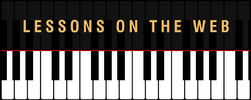|
Chords are a huge part of our piano music. We start playing chords very soon after we start playing the piano because we encounter them in almost all of our music whether it’s a piano piece or an etude that we’re working on. Learning how to identify chords is just as important. There are many different types of chords that are built upon each note in a scale. As key signatures and notes change with each new scale that we play, so do the chords change by the new notes in the new key signature. Chord patterns are almost like vessels…they provide the framework that we then fill in with the notes in each key. When you are able to identify chords and the notes that they contain by sight, you’re music reading is going to take on an incredible new level that will make your playing much easier! In order for you to be able to identify a chord by sight, you need to understand how chords are constructed and what specific notes are in each chord, or…how to spell each chord. (Think of notes as letters that spell out words).
Chords are constructed in many different ways. Just like with our scales and pieces, we start with the simplest and then learn the harder ones as we progress and can build upon our basic foundation. We build chords with a specific number of notes and a chord are named in part, based on how many notes it has in it. One example is a Triad.
There are different intervals in each of these different chord positions that are important to learn as well. Intervals are simply the number of spaces between notes, counting the original note as 1, and then the next note is 2, and so on. Triads have 3 notes in them.
These formulas teach you the basics of how to understand chord structure, how to identify what position a chord in, and how important it is to learn what notes make up each chord in a given key signature. Once you have this down, you’ll be able to apply this to more complex chords that are made up of 4, 5, or even 8 notes, and be able to identify them by sight in all the different key signatures and play them easily on the piano. I go over all of this and play many different examples of chords that go beyond the triad to give you a chance to practice identifying and playing lots of chords on the piano. Take some time to play these at your piano while watching this video so you can really understand the concepts which will help you at any level of playing. If you like my tips and lessons, you will love the courses over on my website. Whether you are a beginner looking to get a solid foundation to build on or you are looking to take you existing skills to that next level, the online music courses on my website https://www.pianolessonsontheweb.com will help you do just that.
4/6/2022 02:04:38 am
Oh, okay. I never would've thought that sticking to a group of three notes can help us better comprehend the core structure of a chord progression. I say this because my nephew has been assigned to play a keyboard for his school's talent show next month. I'll make sure he remembers this trick when he refers to an expert to learn more.
Reply
Leave a Reply. |
AuthorMost blogs written by Archives
June 2020
Categories
All
|

 RSS Feed
RSS Feed